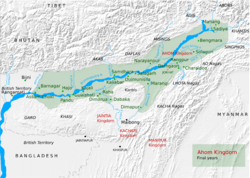Ahom (ethnicity)

The Ahom are a former Tai- speaking population in what is now Assam , who immigrated to northeast India. The most important migration movement came from Yunan under the leader Siu Ka Pha in 1228 . The Ahom called themselves Asam , a corruption of Shan , an ethnic group in Burma and northern Thailand to which they are closely related. Their name is also the origin of what is now the Indian state of Assam, the area of which they ruled for around 600 years.
history
Siu Ka Pha probably led the Ahom from the northeast to Assam, crossing the Patkai Mountains , which now separate Burma from India. He carried an army of 9,000 soldiers who easily overran the Nagas , Kacharis, and other tribes. The group eventually reached the Dihing River , a tributary of the Brahmaputra , and entered its valley. They sat down in 1229 and formed the first Tai settlement in the area. The settlement proved unsuitable because of the frequent floods of the Brahmaputra, which is why Siu Ka Pha looked for better areas for a settlement. In 1252 the landscape of Sivasagar was found in Upper Assam and a capital was built for a principality with Siu Ka Pha as the first king (or swargadeo ).
The Ahom soldiers were very powerful and established a first dynasty in Assam, but they had come without women who could speak Tai . Therefore, they took wives of various ethnic groups during their thousands of kilometers of migration. Their language was the official language of the kings and courts, but for most of its history it was spoken by a minority of the population. Today it is extinct and only exists as a written language . Therefore, today's Ahom who live in Assam are considered Assamese .
The Ahom's successes brought them into conflict with the powerful Mughal empires , whose kings tried to subjugate the Ahom a total of 17 times between 1527 and 1682. The last great attempt, in 1671 at the battle of Saraighat , left its most famous military leader in Lachit Barphukhan . However, according to tradition, he murdered his own uncle because he neglected his military service.
After the final victory over the Mughal empire, a chaotic period broke out in Assam, which was only ended by the greatest king of the empire, Rudra Singha , who ruled from 1696 to 1714. This era is seen as the golden era of the Ahom Empire, building structures, tackling social projects, and achieving military success. After the king's death, the empire broke apart and was first defeated by the Burmese in 1817 and by the British in 1826. This was mainly due to the suppression of religious groups, such as the followers of Vishnu , who then struck back against the central state with palace intrigues and throne disputes. This led to a gradual weakening of the kingdom.
In 1817 the Ahom dynasty was ended by the Burmese and Assam fell to the British in the First Anglo-Burmese War .
The loss of power was followed by a decline in the language and culture of the Ahom, and they largely assimilated into Hindu and an Indo-European language ( Assamese ) speaking Assamese in the course of the 19th century .
Efforts have been made since the 1960s to revive the Ahom identity and the language and culture that goes with it. The driving force behind this was an organization called Ban Ok Publik Muang Tai , which was also supported by a former Prime Minister of Assam, Hiteshwar Saikia . Parts of the Ahom descendants renounced Hinduism and practice a renewed religion, which they call Phra Lung and which is mainly based on ancestor worship as well as traditional chants and rituals. At the political level, the striving for independence was represented by the All Assam Students' Union (AASU) and the United Liberation Front of Asom (ULFA). The latter also enjoyed the support of Thai scientists and the separatist movements of the Shan and Kachin in Myanmar . They received additional legitimacy through the research of Barend Jan Terwiel , an anthropologist who specializes in the languages and cultures of the Tai peoples. In 1979 he was encouraged to study Ahom rituals and scriptures by Domboru Deodhai, whom he initially believed to be the last priest of an ancient pre-Buddhist Tai religion.
literature
- Barbara A. West: The Peoples of Asia and Oceania . New York: Facts on File 2009. ISBN 0816071098 . Article: "Ahom".
- Yasmin Saikia: Fragmented Memories. Struggling to be Tai-Ahom in India. Duke University Press, Durham NC 2004.
- Saikia: The Tai-Ahom Connection. In: India Seminar (Web Edition), 2005.